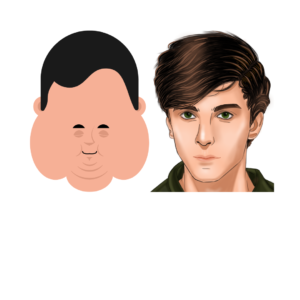Introduction :
A slim, defined face is often seen as a sign of health and vitality. However, many people struggle with excess fat on their faces, which can lead to a fuller or puffier appearance. While spot reduction—losing fat in a specific area—is largely a myth, there are effective strategies that can help you achieve a leaner face.
You can reduce face fat and enhance your facial contours by combining targeted facial exercises, overall weight loss techniques, a balanced diet, and healthy lifestyle changes. This comprehensive guide will walk you through the best exercises and tips to help you achieve a slimmer, more sculpted face.
Top11 Exercises and Tips to Lose Face Fat
Table of Contents
 Losing face fat can be challenging, but you can achieve a slimmer, more defined face with the right combination of exercises, dietary changes, and lifestyle adjustments. Here are some effective exercises and tips to help you lose face fat:
Losing face fat can be challenging, but you can achieve a slimmer, more defined face with the right combination of exercises, dietary changes, and lifestyle adjustments. Here are some effective exercises and tips to help you lose face fat:
1. Facial Exercises
a. Cheek Puff Exercise
- How to do it: Puff out your cheeks and move the air from one cheek to the other. Repeat this for a few minutes.
- Benefits: This exercise helps tone the muscles in your cheeks, giving them a more sculpted look.
b. Jaw Release Exercise
- How to do it: Sit or stand with your back straight. Move your jaw as if you are chewing, keeping your lips closed. Breathe in deeply and hum as you exhale.
- Benefits: This exercise strengthens the jaw muscles and can reduce a double chin.
c. Fish Face Exercise
- How to do it: Suck in your cheeks and lips to make a fish face. Hold this position for a few seconds and then relax. Repeat several times.
- Benefits: It tones and stretches the cheek muscles, helping to slim down the face fat.
2. General Weight Loss
a. Cardiovascular Exercise
- How to do it: Engage in activities like walking, jogging, cycling, or swimming for at least 30 minutes a day.
- Benefits: Cardio helps burn overall body fat, which can also reduce fat in your face.
b. Strength Training
- How to do it: Incorporate weight lifting or body-weight exercises like push-ups, squats, and lunges into your routine.
- Benefits: Building muscle increases your metabolism, helping you burn more fat throughout the day.
3. Healthy Diet
a. Hydration
- How to do it: Drink at least 8 glasses of water a day.
- Benefits: Staying hydrated helps reduce bloating and puffiness in the face.
b. Balanced Diet
- How to do it: Eat a diet rich in fruits, vegetables, lean proteins, and whole grains. Avoid processed foods and sugary drinks.
- Benefits: A balanced diet helps manage your weight and provides essential nutrients for healthy skin.
c. Reduce Salt Intake
- How to do it: Avoid salty snacks and reduce the amount of salt you add to your food.
- Benefits: Lowering salt intake helps prevent water retention, which can make your face look puffy.
4. Lifestyle Changes
a. Get Enough Sleep
- How to do it: Aim for 7-9 hours of sleep each night.
- Benefits: Proper sleep helps reduce stress and prevents your face from looking tired and swollen.
b. Manage Stress
- How to do it: Practice relaxation techniques such as meditation, yoga, or deep breathing exercises.
- Benefits: Reducing stress can help prevent weight gain and bloating, including in the face.
c. Avoid Alcohol
- How to do it: Limit your alcohol intake or avoid it altogether.
- Benefits: Alcohol can cause dehydration and bloating, making your face appear fuller.
5. Good Posture
a. Maintain Proper Posture
- How to do it: Keep your head up and shoulders back, whether sitting or standing.
- Benefits: Good posture helps prevent double chins and can make your face appear slimmer.
6. Skincare Routine
a. Regular Cleansing and Moisturizing
- How to do it: Wash your face twice daily and use a good moisturizer.
- Benefits: Keeping your skin clean and hydrated improves its appearance and elasticity.
b. Facial Massage
- How to do it: Use gentle, circular motions to massage your face with your fingers or a facial roller.
- Benefits: Facial massage increases blood circulation and can reduce puffiness
Consistent Facial Exercise Routine
a. Chin Lifts
- How to do it: Tilt your head back until you’re looking at the ceiling. Pucker your lips as if you’re kissing the ceiling and hold for a few seconds. Repeat several times.
- Benefits: This exercise helps strengthen and tone the muscles in your neck and jawline, reducing the appearance of a double chin.
b. Neck Roll
- How to do it: Sit or stand up straight. Gently roll your head in a circular motion, stretching out your neck muscles. Do this slowly to avoid strain.
- Benefits: Neck rolls can help reduce neck fat and improve blood circulation, leading to a slimmer neck and face.
c. Lip Pull
- How to do it: Lift your lower lip as high as possible by pushing out your lower jaw. Hold the position for a few seconds and then relax. Repeat multiple times.
- Benefits: This exercise helps in lifting the facial muscles, giving you a more youthful appearance with reduced sagging.
8. Mindful Eating Habits
a. Portion Control
- How to do it: Be mindful of your portion sizes and avoid overeating by using smaller plates and bowls.
- Benefits: Controlling your portions helps manage overall calorie intake, promoting weight loss that can also reduce face fat.
b. Chew Slowly
- How to do it: Take your time to chew your food thoroughly before swallowing.
- Benefits: Eating slowly helps you recognize when you’re full, preventing overeating and aiding in better digestion.
9. Incorporate Antioxidant-Rich Foods
a. Fruits and Vegetables
- How to do it: Include a variety of colorful fruits and vegetables in your diet.
- Benefits: Foods rich in antioxidants help combat inflammation and promote healthy skin, which can enhance the appearance of your face.
b. Green Tea
- How to do it: Drink a cup of green tea daily.
- Benefits: Green tea contains antioxidants and compounds that boost metabolism, aiding in fat loss and improving skin health.
10. Avoid Sugary Drinks and Snacks
a. Cut Down on Sweets
- How to do it: Limit your intake of sugary snacks and beverages like soda and candy.
- Benefits: Reducing sugar intake helps prevent weight gain and reduces bloating, making your face look slimmer.
11. Facial Yoga
a. The Lion Face Pose
- How to do it: Sit comfortably, open your mouth wide, and stick your tongue out as far as possible while opening your eyes wide. Hold for a few seconds and then relax.
- Benefits: This yoga pose strengthens facial muscles and can reduce face fat while improving blood circulation.
b. Eye Focus
- How to do it: Keep your head still and look up as far as you can, then look down. Repeat this several times.
- Benefits: This exercise helps tone the muscles around your eyes and forehead, reducing puffiness and fine lines.
.
Precautions for Losing Face Fat
 While working towards a slimmer, more defined face, it’s important to take certain precautions to ensure that you are approaching your goals in a healthy and safe manner. Here are some key precautions to keep in mind:
While working towards a slimmer, more defined face, it’s important to take certain precautions to ensure that you are approaching your goals in a healthy and safe manner. Here are some key precautions to keep in mind:
1. Avoid Extreme Diets
- Why: Extreme or crash diets can lead to nutritional deficiencies and negatively impact your overall health, including skin and muscle tone.
- Precaution: Focus on a balanced diet that includes a variety of nutrients to support overall health and sustainable weight loss.
2. Be Gentle with Facial Exercises
- Why: Overdoing facial exercises can strain the muscles and lead to discomfort or injury.
- Precaution: Perform facial exercises gently and in moderation. Start slowly and increase intensity gradually.
3. Stay Hydrated
- Why: Dehydration can lead to water retention, causing your face to look puffier.
- Precaution: Ensure you drink adequate daily water to maintain proper hydration levels.
4. Avoid Overconsumption of Caffeine and Alcohol
- Why: Both caffeine and alcohol can dehydrate the body and cause bloating, which may make your face appear fuller.
- Precaution: Limit your intake of caffeinated beverages and alcohol to prevent dehydration and puffiness.
5. Get Professional Advice for Treatments
- Why: Certain professional treatments like radiofrequency therapy or laser treatments can have side effects if not done properly.
- Precaution: Consult with a qualified dermatologist or skincare professional before undergoing any advanced treatments to ensure they are suitable for you.
6. Do Not Overuse Salt
- Why: Excessive salt intake can lead to water retention and bloating, affecting the appearance of your face.
- Precaution: Monitor your salt intake and opt for a low-sodium diet to reduce the risk of puffiness.
7. Maintain a Healthy Sleep Schedule
- Why: Lack of sleep can cause stress and increase cortisol levels, which can lead to weight gain and a puffy face.
- Precaution: Aim for 7-9 hours of quality sleep each night to support overall health and facial appearance.
8. Practice Good Skincare Hygiene
- Why: Poor skincare can lead to breakouts, irritation, and other issues that might detract from your facial appearance.
- Precaution: Cleanse your face regularly, use suitable moisturizers, and avoid harsh chemicals that can damage your skin.
9. Be Patient and Consistent
- Why: Quick fixes are often unsustainable and can harm your health.
- Precaution: Approach face fat loss with a long-term mindset, being consistent with healthy practices rather than seeking immediate results.
10. Avoid Excessive Sun Exposure
- Why: Prolonged sun exposure can damage your skin, leading to premature aging and a less healthy appearance.
- Precaution: Use sunscreen and wear protective clothing when exposed to the sun to maintain skin health.
Tips in Diet for Fast Fat Loss
 Vegan protein source. Buddha bowl dish, avocado, pepper, tomato, cucumber, red cabbage, chickpea, fresh lettuce salad and walnuts, nuts, beans. Healthy vegetarian eating, superfood. Top view.[/caption]
Vegan protein source. Buddha bowl dish, avocado, pepper, tomato, cucumber, red cabbage, chickpea, fresh lettuce salad and walnuts, nuts, beans. Healthy vegetarian eating, superfood. Top view.[/caption]
Losing fat quickly and safely involves making strategic adjustments to your diet. Here are some effective tips to help you achieve your fat loss goals:
1. Increase Protein Intake
- Why: Protein helps build and repair muscles, boosts metabolism, and keeps you feeling full longer.
- How: Incorporate lean protein sources such as chicken, turkey, fish, eggs, tofu, beans, and Greek yogurt into every meal.
2. Eat More Fiber
- Why: Fiber aids digestion, helps control blood sugar levels, and keeps you feeling satiated, reducing overall calorie intake.
- How: Include high-fiber foods like vegetables, fruits, whole grains, legumes, nuts, and seeds in your diet.
3. Drink Plenty of Water
- Why: Staying hydrated helps your body function optimally, reduces hunger, and can aid in weight loss.
- How: Aim for at least 8 glasses of water a day. Drinking a glass of water before meals can also help you eat less.
4. Cut Back on Sugary Foods and Drinks
- Why: Sugary foods and drinks are high in calories and can lead to weight gain and increased fat storage.
- How: Avoid sodas, candies, baked goods, and other high-sugar items. Opt for natural sweeteners like fruits if you crave something sweet.
5. Avoid Refined Carbohydrates
- Why: Refined carbs like white bread, pasta, and pastries can spike blood sugar levels and contribute to fat gain.
- How: Choose whole grains such as brown rice, quinoa, oats, and whole-wheat products instead.
6. Include Healthy Fats
- Why: Healthy fats can help you feel full and satisfied, preventing overeating.
- How: Incorporate sources of healthy fats like avocados, nuts, seeds, olive oil, and fatty fish (like salmon) into your diet.
7. Eat Smaller, More Frequent Meals
- Why: Eating smaller, more frequent meals can help regulate blood sugar levels and prevent overeating.
- How: Plan to eat 5-6 smaller meals throughout the day rather than 2-3 large ones.
8. Monitor Portion Sizes
- Why: Large portion sizes can lead to overeating and excessive calorie intake.
- How: Use smaller plates and bowls to help control portions, and be mindful of serving sizes when eating out.
9. Limit Alcohol Consumption
- Why: Alcohol contains empty calories and can contribute to weight gain and fat accumulation.
- How: Reduce your alcohol intake, and choose lower-calorie options when you do drink, such as light beer or wine.
10. Plan and Prepare Your Meals
- Why: Planning and preparing meals in advance can help you make healthier choices and avoid last-minute unhealthy eating.
- How: Set aside time each week to plan your meals, make a grocery list, and prepare healthy meals and snacks.
11. Avoid Late-Night Snacking
- Why: Eating late at night can lead to weight gain as your body may not burn off the calories efficiently.
- How: Try to finish your last meal of the day at least 2-3 hours before bedtime.
12. Choose Low-Calorie, Nutrient-Dense Foods
- Why: Low-calorie, nutrient-dense foods provide essential nutrients without excessive calories, aiding in weight loss.
- How: Focus on vegetables, fruits, lean proteins, and whole grains that are high in nutrients but low in calories.
Foods to Avoid for Fast Fat Loss

To achieve fast and effective fat loss, it is important to avoid certain foods that can hinder your progress. Here are some foods to steer clear of:
1. Sugary Foods and Drinks
- Examples: Sodas, candies, cookies, cakes, pastries, and ice cream.
- Why: High in empty calories and sugar, which can lead to weight gain and increased fat storage.
2. Refined Carbohydrates
- Examples: White bread, white rice, pasta, pastries, many breakfast cereals.
- Why: They are quickly digested and can cause spikes in blood sugar levels, leading to increased hunger and overeating.
3. Fried Foods
- Examples: French fries, fried chicken, fried snacks, doughnuts.
- Why: High in unhealthy fats and calories, which can contribute to weight gain and poor heart health.
4. Processed Foods
- Examples: Fast food, frozen meals, processed meats (like sausages, hot dogs, and bacon), snack foods.
- Why: Often high in unhealthy fats, sugars, and sodium, and low in nutritional value.
5. High-Calorie Snacks
- Examples: Potato chips, nachos, popcorn with butter, cheese puffs.
- Why: These snacks are typically high in calories and low in nutrients, leading to weight gain.
6. High-Sugar Breakfast Cereals
- Examples: Sweetened cereals, and granola with added sugars.
- Why: They can cause a spike in blood sugar levels, leading to increased hunger and calorie intake throughout the day.
7. Full-Fat Dairy Products
- Examples: Whole milk, full-fat cheese, cream, butter.
- Why: High in saturated fats and calories, which can contribute to weight gain.
8. High-sugar yogurts
- Examples: Flavored yogurts with added sugars.
- Why: These can contain as much sugar as a candy bar, leading to increased calorie intake and fat storage.
9. High-calorie condiments and Sauces
- Examples: Mayonnaise, creamy salad dressings, ketchup, barbecue sauce.
- Why: Often high in sugars and unhealthy fats, adding extra calories to meals without providing much nutritional value.
10. Alcohol
- Examples: Beer, cocktails, wine, sugary mixed drinks.
- Why: Alcoholic beverages contain empty calories and can lead to weight gain, especially when consumed in excess.
11. Baked Goods
- Examples: Cakes, muffins, pastries, pies.
- Why: Typically high in sugar, unhealthy fats, and calories, contributing to weight gain.
12. Fast Food
- Examples: Burgers, fries, fried chicken, pizza.
- Why: High in unhealthy fats, sugars, and calories, which can hinder fat loss efforts.
13. High-Sugar Fruit Juices
- Examples: Commercial fruit juices, juice cocktails.
- Why: These juices often contain added sugars and lack the fiber found in whole fruits, leading to rapid spikes in blood sugar levels.
- Avoiding these high-calorie, low-nutrient foods can significantly enhance your fat-loss efforts. Focus instead on whole, nutrient-dense foods that support your overall health and weight loss goals.
- Remember, a balanced diet combined with regular exercise and healthy lifestyle habits will provide the best results for sustainable fat loss.
Conclusion

Losing face fat is often a reflection of overall body fat reduction and can be influenced by various factors including diet, exercise, hydration, and lifestyle changes. By adopting a balanced diet rich in protein and fiber, staying hydrated, exercising regularly, and avoiding foods high in sugars, unhealthy fats, and refined carbohydrates, you can promote fat loss healthily and sustainably. Additionally, reducing alcohol and salt intake, managing stress, and ensuring adequate sleep can further support your efforts.
Understanding the reasons behind facial fat loss—whether intentional or due to natural processes like aging—allows you to take a mindful approach to your health and fitness goals. For those experiencing rapid or unexpected changes, consulting a healthcare professional can provide valuable insights and ensure there are no underlying health concerns. Overall, consistency, patience, and a holistic approach to wellness are key to achieving and maintaining a slimmer, healthier face.
FAQS About Losing Face Fat

1. Can I specifically target face fat for loss?
No, spot reduction is a myth. When you lose weight, you lose fat from all over your body, including your face. Overall weight loss through a balanced diet and regular exercise is the most effective way to reduce face fat.
2. What are the best exercises to lose face fat?
Facial exercises like cheek puffs, jaw releases, and fish faces can help tone and strengthen facial muscles, contributing to a more defined appearance. However, overall cardiovascular and strength training exercises are crucial for general fat loss.
3. How long does it take to see results in face fat loss?
The time it takes to see results can vary based on individual factors such as diet, exercise routine, and genetics. Generally, consistent healthy eating and exercise can lead to noticeable changes within a few weeks to a few months.
4. Does drinking more water help reduce face fat?
Yes, staying hydrated helps reduce water retention and bloating, which can make your face look slimmer. Proper hydration also supports overall health and weight loss efforts.
5. Can certain foods cause my face to look puffier?
Yes, foods high in sodium and sugar can cause your body to retain water, leading to a puffier face. Reducing your intake of these foods can help minimize bloating and puffiness.
6. Will cutting out alcohol help reduce face fat?
Yes, alcohol contains empty calories and can lead to dehydration and bloating. Reducing or eliminating alcohol can help decrease overall calorie intake and reduce puffiness in the face.
7. Why does my face look thinner as I age?
As people age, they naturally lose fat in certain areas, including the face. Additionally, changes in skin elasticity can contribute to a leaner appearance.
8. Is there a specific diet that can help reduce face fat?
A balanced diet that is low in refined carbohydrates, sugars, and unhealthy fats, and high in protein, fiber, and healthy fats can promote overall weight loss, including face fat. Staying hydrated and reducing salt intake also helps.
9. Can poor sleep affect face fat?
Yes, lack of sleep can increase stress levels and cortisol, which can lead to weight gain and a puffier face. Getting adequate sleep is important for overall health and maintaining a slimmer face.
10. Should I consult a doctor if I notice rapid facial fat loss?
Yes, if you experience rapid or unexplained facial fat loss, it’s important to consult a healthcare professional to rule out any underlying health conditions.
11. Are there medical treatments for reducing face fat?
Yes, there are medical treatments such as facial liposuction and non-invasive procedures like radiofrequency therapy. However, these should only be considered after consulting with a qualified healthcare provider and exploring natural methods first.
12. Can stress cause facial fat or bloating?
Yes, stress can lead to increased cortisol levels, which can cause weight gain and bloating, including in the face. Managing stress through relaxation techniques, exercise, and adequate sleep can help.

